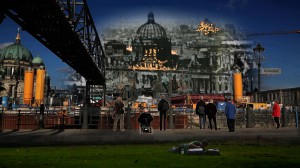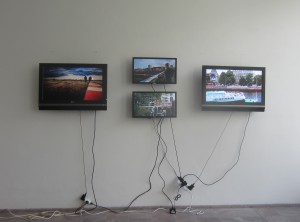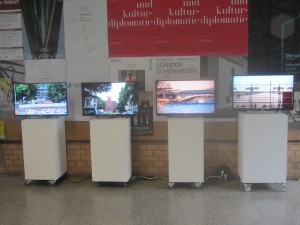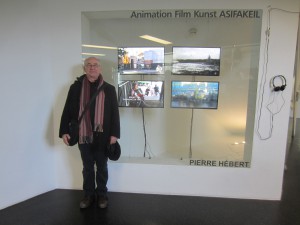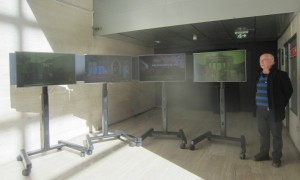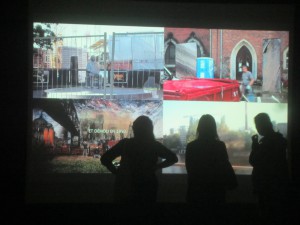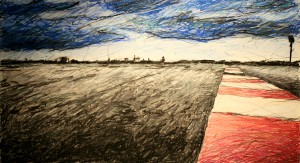Berlin – The Passage of Time (Places and Monuments-6) Four channels video installation by Pierre Hébert
Distributed by Vidéographe
The Berlin – The Passage of Time video installation is shown on four HD flat screens positioned horizontally one beside the other. Four video clips of different lengths (between seven and twelve minutes) are looped on those screens. Since the loops are of different lengths, they are constantly lagging one in relation to the others so that the viewer is facing ever changing combinations of the different segments of images and sounds.
Each of the segments is based on shooting done in Berlin in July 2012, august 2013 and October 2013. All those shootings have to do with scenes of daily life, but in the same time, they also refer to different episodes of the recent history of the city of Berlin, from the Weimar Republic to the Second World War, the monumental buildings of the DDR, the 1949 blockade and airlift, the Wall and so on to the current rebuilding of the city center. Some segments (images shot from the S-Bahn, the parade of the tourists boats on the Spree, the constant traffic of bicycles) have a function of transitions and constitute leitmotivs that are present in all four screens.
There are two segments devoted to two major intellectual figures related to Berlin, that are dear to me, Bertolt Brecht and Walter Benjamin, two characters that had crossed over destinies during WW II. Overall the piece is particularly inspired by different benjaminian themes, like the image of the «flanneur», a special understanding of history and of the relationship between present and pass, the notions of dialectic images and allegory.
Each shot is first submitted to digital processing in order to achieve a greater density of the material. Eventually, meshes of animated lines are added. The objective is, while keeping a strong connection with the initial raw live material, to modify the viewer’s perception, to allegorize those fragments of daily life, and to create a sort of historical vertigo. At another more formal level, there is a construction of moments of intensity that creates at the level of the four screens a composition of dynamic chocks constantly reenacted by the lag between the four different loops. This is superposed to the equally shifting thematic connections between what is seen on the different screens. This combinatory and expanded editing on multiple levels invites the viewer to position himself alternately in the overall contemplation of the changes in the global installation, and in the concentrated observation of specific fragments while moving from one screen to the other.
The longest loop is 13 minutes, so the complete set of images of the piece can be seen in that length of time. But, because of the combinatory manner in which it is constructed, it is possible to stay in hypnotic contemplation much longer in front of the installation.
This installation piece is subtitled “Places and Monuments-6” because it is number 6 of a wider project that will eventually include a large number of glimpses of the course of things from all over the world. Up to now in this series of works, four short films were completed : Praha-Florenc (no 1), Place Carnot – Lyon (no 2), Thunder River (no 4), and John Cage – Halberstadt (no 5). A Tokyo piece (no 3) is unfinished. A web version of Berlin – The Passage of Time was put on line at the time of the first presentation of the installation.
General informations about the Places and Monuments Series
List of presentations:
* March 1st mars – April 20 2014 Presentation of the installation in the main foyer of the Forum des images, in Paris, during the event «Berlin magnétique».
* March 13 – June 29 2014 Presentation of the installation in the Foyer Luce-Guilbault at the Cinémathèque québécoise in Montreal.
Watch the video and visit the galery of stills. See the web version.
* October 29 – November 15 2014, House for the arts of Brno (Dům umění města Brna), Czech Republic.
* November 3 to 6 2014, Universität für Angewandte Kunst Wien (The Vienna Unisersity of Applied Arts), Vienna.
* January 15 to March 29 2015, Goethe Institut of Montréal, projected in three windows, to be seen from the streets.
* February and March 2015, ASIFA Austria space at MuseumQuartier, Vienna.
* February 2014, at CCCB (Centre de Cultura Contemporania de Barcelona), Barcelona.
* june 12 to 14 2015, in the event «La friche est Berlin», 24h CHRONO, Friche Belle de Mai, Marseille.
* October 30 to November 6 2015, at the Municipal Library of Rouyn-Noranda (Canada) presented by the Festival du film international d’Abitibi-Témiscamingue .
Technical requirements:
4 HD flat screens with HDMI connections, 4 sd cards media player (no need of synchronization). Ideally, the screens should be placed side by side in an horizontal line. But it is also possible to position them in a square pattern (two screens high and two screens wide like in the web version). Each loop has its own sound track that can be played separately by the screen’s speakers, or the four sources can be mixed into one stereo track and be listened to through headphones. When the setup is horizontal, it is preferable to play the sound through the screen’s speakers because a natural mix between the four tracks is induced by the movements of the viewer from one screen to the other. The installation currently comes in two different versions, English or French, but if needed, versions in other languages would be easy to make.
Content of the installation :
The four clips can be seen here : clip-1, clip-2, clip-3, and clip-4.
A shooting of the installation as presented at Cinémathèque québécoise can also be seen. It should be noted that in this case, the eight drawings that are included in the four clips were exhibited on the side walls of the space. This created an interesting effect, but the four video screens are the core of the installation and can be exhibited without the drawings. This is how it was shown at Forum des Images in Paris. When the exhibition space allows for it, this is an interesting option either with the original drawings or reproductions.
The total length of the piece is 1200 years (that is the time it would take to get the relationship between the four screens back to its initial state).
A visit to the WEB VERSION OF THE INSTALLATION can give a good idea of the combinatory scope of the piece. But it have to be noted that in this version the recombination of the different segments is done by randomly permutating them, wich is different than the way it works in the installation through the lagging effect between loops of different lengths. The web version, although it is constituted of the same material, is a different work with its own specific character.
Interview with Pierre Hebert about the installation, directed by Eric Berthiaume from the Goethe Institut in Montreal (in French only) :
Credits :
Direction, shooting, editing and animation : Pierre Hébert
Assistents : Nicolas Brault and Clémence Renaud-Allaire.
Music : John Barrett
Sound mixing : Luc Boudrias
Thanks to John Barrett, Philippe Noble and Paolo Polesello for their help during the shooting in Berlin.
This piece was made possible by the help of the Conseil des arts et des lettres du Québec and of the artist center Vidéographe.
Web version production : Ottoblix
Developper : François Genois
Web version : www.lieuxetmonuments.net
Pierre Hébert’s Curiculum Vitae
Text about the project : Places and Monuments – Transforming the Temporal Flux
Text about Berlin – The Passage of Time
See the notes (in French only)
